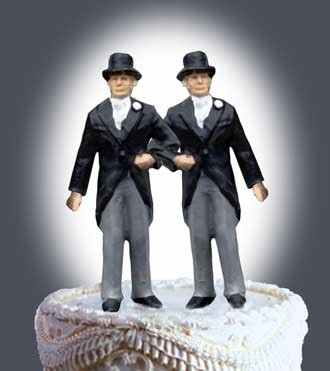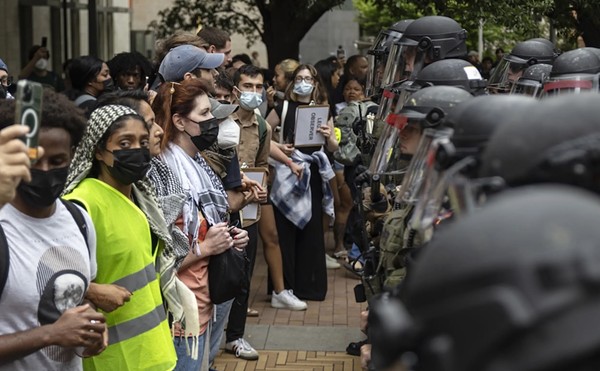What’s marriage got to do with it?
Prop 2 does little to support marriage, and may even dissolve common-law unions
By Susan PaganiSupporters say it will protect the institution of marriage. Opponents say it will write bigotry into the Texas constitution. But, if Proposition 2 passes, it’s unclear what consequences the sweeping state Bill of Rights amendment banning gay marriage and anything “identical or similar” to it, will have.
The first sentence of the amendment defines marriage as consisting “only of the union of one man and one woman.” Texas already has a law banning marriage between gays and lesbians; those in favor of the marriage amendment say it will defend the law from judicial challenge.
That argument has been used to pass similar amendments in 18 states, but Texas’ amendment differs in its vague second sentence, which prohibits the state, or any subdivision of the state, from recognizing “any legal status identical or similar to marriage.” If the law passes, opponents say, it could effectively outlaw common-law marriage, known as informal marriage in Texas. That would bar gay and lesbian couples from using future legislation to secure the benefits of marriage through common-law marriage or domestic partnerships, but it could also dissolve and prohibit the informal marriages of heterosexual couples as well.
“I’m very concerned that, if passed, Prop 2 would wipe out informal marriage in Texas,” says Austin attorney Robert F. Andrews, who practices constitutional law. “It was added without a study, on the House floor. It was designed to knock out civil union, but identical or similar’ leaves it open as to whether that includes informal marriage or simply marriage. And there is nothing in our laws that defines marriage as both informal marriage and ceremonial church marriage.”
| Stories included in this feature: TAKING CONTROL Crime-control district asking for sales-tax increase to fight bad guys DECODING THE BALLOT A list of the ballot propositions, what they mean, and the arguments for and against |
Informal marriage registration is administered by the county clerk, Andrews says, which would fall under “subdivision of the state.” It appeals to low-income couples and those not active in a church because “it is less expensive and quite a bit more convenient all you have to do is go to the courthouse and declare your intention to be married and you are.
“If the amendment is read to protect ceremonial church marriage, it could have dire economic impact, especially in our lower-income areas.”
Former State representative Glen Maxey (D-Austin), currently the campaign manager of the No Nonsense in November political action committee, which opposes the bill, adds that the vague language would call into question privately contracted wills, medical directives, and property contracts if a hospital decides to interpret the amendment conservatively or family members contest the deceased’s or sick person’s marriage-like relationship. “Theoretically, people who have the money to hire an attorney can litigate, but everyone else gets screwed,” Maxey says. “People have these fights now, even with the legal documents and common-law marriage; why risk it?”
“That’s totally false,” says Kelly Shackelford, president of the conservative policy organization Free Market Foundation and spokesman for Texans FOR Marriage PAC. “They are being dishonest and they know it. Common-law marriage is marriage, which is between a man and a woman. There’s no doubt this (amendment) has no effect on that.”
| Who is funding the debate over Prop 2 AGAINST THE AMENDMENT Vote Against the Amendment $159,694 • Tim Gill $100,000 • National Gay and Lesbian Task Force $59,694 No Nonsense in November $160,745 (Primarily individual donations under $500) • Human Rights Campaign $25,000 • Lesbian/Gay Rights of Texas $25,000 FOR THE AMENDMENT Texans FOR Marriage $108,324.36 • Free Market Foundation (Kelly Shackelford) $5,474.36 • James Leinenger $100,000 Texas Marriage Alliance $10,100 • Bob Perry $10,000 • PRI (John Colyandro and Jim Ellis, who are indicted in the TRMPAC Case) $100 |
The risk, says Shackelford, is that the statute that makes it illegal for gays and lesbians to marry could be overturned by an “activist judge,” and that legislation doesn’t go far enough in defining marriage. “The amendment protects an institution that is crucial and foundational,” he says. “The definition of marriage that has existed for 6,000 years, I’ve never heard the opponent come up with an alternative that is controllable the best they can do is commitment and love; well, that could involve five or six people.”
Opponents to the amendment, including not only gay-rights activists but also politicians and religious leaders, have been outspoken in saying that a law denying rights to any group of citizens does not belong in the states Bill of Rights. “Prop 2 would take a step back in our country’s history of expanding social justice by putting bigotry into the state constitution,” says representative Mike Villarreal (D-San Antonio). “At one time there were a dozen states that would have made my marriage to my Anglo wife illegal, but that law was overturned by a constitutional challenge. Prop 2 is hateful, and there are more pressing issues in the legislature.”
Shackelford calls that argument “disingenuous,” saying “I love my brother, but that doesn’t mean I should call it marriage. The marriage amendment protects future citizens it’s important to have a mom and a dad, it does something for society. Texas encourages that definition of marriage, it says. This relationship is special.”
“If you want to strengthen marriage, outlaw divorce,” says Senator Leticia Van de Putte (D-San Antonio). “We have a strong, committed gay couple living across the street. Nothing they do threatens the marriage between `my husband` Pete and I, and they provide stability for the neighborhood and our kids. This amendment just furthers the Us versus Them mentality.”
In other states, marriage amendments have tended to pass by large margins; Mississippi’s passed by 86 percent, Louisiana’s by 78 percent, Oklahoma’s by 76 percent, and Arkansas’ by 75 percent. Relatively liberal Oregon passed the amendment by only 56 percent.
In off-year elections, Texas tends to have a voter turnout of around 5-7 percent, which means a few people could decide the fate of same-sex and common-law marriage. “Many people don’t even know we are having an election,” says Shackelford. “But I don’t think people are going to have their minds changed in the coming week: Texans believe marriage is between a man and a woman. If they show up to vote, it will pass.”
If voters pass the amendment, removing it would require another amendment, which would have to pass by two-thirds of the Texas House and Senate and another referendum. “We’ve amended the Texas constitution 27 times in 200 years,” says Michael Ariens, a St. Mary’s University constitutional law professor. “It is more difficult to change than legislation, but it’s not set in stone.
“On the other hand, any time you put something in the constitution you are going to make a statement about the fundamental law. So, the battle is, What do we as people in Texans think is fundamental law? If society decides that gay marriage is acceptable to the majority it will change the law, whether it’s an amendment or legislation.”
Yet opponents of the amendment say it will impede further discussion of the issue, and that its second sentence will close the door on future alternatives to marriage. “One doesn’t have to understand, believe, or support gays and lesbians, but they are citizens of this country and state, and are entitled to protection under the law,” says Chuck Smith, spokesman for the Lesbian/Gay Rights Lobby of Texas. “The amendment doesn’t make people work harder to preserve marriage. All it does is hurt gays and lesbians who are trying to protect their families and relationships.” •
By Susan Pagani
Taking control
Crime-control district asking for sales-tax increase to fight bad guys
By Michael CaryThe citizenry of Fort Worth was under siege by gangs and other violent criminals in the mid-1990s. In an attempt to reduce gang violence and violent crimes by at least 50 percent, Fort Worth residents voted to create the state’s first sales-tax-funded crime control and prevention district.
Fort Worth voters renewed the district in 2000, and recently, with a vote of more than 90 percent, authorized its extension for another five years. In 2004, the district collected $40 million to fund the city’s crime-control programs.
“We had the second-highest crime rate in the nation in 1991,” says David Garrett, planning manager for the Fort Worth Police Department, and an advocate for the district. He adds that most of Fort Worth’s crime-prevention projects were aimed at violent crime, which since 1995 has decreased by 50 percent. “Our goal was to hit a certain crime rate, and we are on pace with our last renewal to meet that goal.”
Fort Worth’s overall crime rate has increased by nearly 8 percent between 2000 and 2003, but the population increased by more than 50,000 during the same time frame.
The Texas legislature authorized cities to establish and fund crime-control districts in 1989. Since then, voters in 37 cities have approved the districts, and San Antonio could be next.
On November 8, San Antonians will have the opportunity to vote for an 1/8-cent sales-tax increase, which would fund a crime control and prevention district for five years. (The district does not include areas outside the city limits.) The district is projected to generate nearly $19 million in its first 12 months, then $20.5 million during the second year.
The sales-tax increase is estimated to cost a family of four about $26 a year.
Questions loom about the district: How will police departments continue to pay for equipment, training, and personnel if the sales tax is not renewed in 2010? And considering that San Antonio’s overall crime rate has not escalated significantly since 2001 it has dropped three of four years why does the city need the district?
Although the City funds its police department through general revenues, Garrett says a common problem with allocating additional funds for crime control is that when the crime rate drops, City officials tend to decrease funding, therefore creating what he calls a “roller-coaster crime effect.”
SAPD Captain Larry Birney says that unlike Fort Worth’s initial goal to reduce crime by 50 percent, the local district board avoided setting benchmarks to reduce the city’s crime rate by percentage points. “We made a decision to stay away from statistics to try not to correlate any statistical reductions with programs.”
Birney says there are a multitude of factors that affect crime rates: weather, economic trends and conditions. “The CCPD would be a positive influence on reducing crime, but I would not come out and say it is the sole factor in reducing crime. Manpower, equipment, program needs, dealing with youth, elderly, all those factors contribute to reductions in crime if education is part of it. All of that costs money, but we have enough manpower to deal with requests for service.”
| San Antonio Police Department budgets 2005 $245.8 million 2004 $219.6 million 2003 $218.6 million 2002 $216.4 million 2001 $201 million 2000 $182 million Source: SAPD SAPD crime statistics Number of crimes 2004 89,107 Number of crimes 2003 90,264 Percentage change -1.3% Number of crimes 2003 90,264 Number of crimes 2002 94,233 Percentage change -4.2% Number of crimes 2002 94,233 Number of crimes 2001 96,498 Percentage change -2.3% Number of crimes 2001 96,498 Number of crimes 2000 86,332 Percentage change 11.8% Source: SAPD Uniform Crime Statistics |
The legislature included a requirement to monitor the effectiveness of crime-control and prevention districts to assure that the money is spent prudently; the district would be monitored through quarterly and annual reports presented to the board of directors.
A temporary seven-member board of directors for the district was appointed earlier this year, and City Council would have to appoint either a seven or 11-member board on November 17, as well as confirm a two-year operating budget the temporary board adopted during a series of meetings this past summer. (A copy of the CCPD’s 88-page proposed budget is available on the City’s website at sanantonio.gov. Click through to the police department).
According to SAPD Uniform Crime Reports, from 2000 through 2004, the number of crimes in San Antonio has increased by 3 percent `see sacurrent.com`. During the same time period, SAPD’s budget increased 20 percent, from $182 million to $219.6 million.
With such a budget increase, why does SAPD need sales-tax money?
“You have to understand budgets,” says Birney. “They are all-inclusive, with everything from police protection to insurance, gasoline, automobiles, contracting services, all included within the budget. Budgets will sometimes increase where services don’t increase, and the cost of services increased. What we’re talking about is doing things above and beyond what we can do within the confines of a city budget. These are new programs, new ways of doing things, and we are asking citizens if they’re willing to support new programs, versus a continuation of what we’ve done in the past.”
A crime-control district ostensibly addresses the funding problem because it creates its own revenue stream. The district funds would be funneled toward buttressing community policing, family violence, juvenile crime and safety, crimes against the elderly, and property crimes against visitors and businesses.
“Right now things are pieced together, but if we had more we can do more, expand services to the family-violence program, expand hours to evenings and weekends,” says Birney. “A lot of our programs are diversified, with programs offered at various agencies. We’re talking about consolidating some of these programs to make them more efficient. We would be creating a crimes against elderly unit, but now it’s handled within individual units; we’re talking about creating one unit and hiring personnel to address the needs of elderly in one place instead of broken apart like it is now. These programs will continue whether or not this initiative is passed.”
Robert Marbut, chairman of the temporary board of directors, served on the former Greater San Antonio Crime Commission, which proposed a crime-control and prevention district several years ago. Marbut also served on the City Council from 1995-99, but he could never get a six-vote majority to put the district on the ballot; Mayor Ed Garza managed to rally support late in his tenure.
“I’m glad to see this finally getting to an election, where the voters can decide whether $26 per year is worth it,” Marbut says. “We will use dedicated revenue for dedicated purposes, the money doesn’t get slushed around everybody knows exactly what they’re getting.”
The local district board considered using sales-tax funds to pay for additional officers, but ultimately decided to “limit the funding of police officers to definable specialized programs and to initial hiring and training time periods.”
If approved by the voters, the local CCPD will limit funding to no more than 100 new police officers. If the CCPD is not renewed after five years, the cost of the new officers might be better absorbed by the City’s general fund.
The initial two-year budget will also pay for the first 10 months of salary and equipment costs for an additional 120 officers. New officers will be assigned to specific programs, such as an enhanced gang-violence detail.
District 7 Councilwoman Elena Guajardo says that when she began her election campaign, her constituents wanted to know what could be done about the City’s crime rate. She learned about the district from patrol officers and she endorses the plan. “It is our moment to say I’m sick and tired, let’s do something about crime. After-school programs, crimes against the elderly, domestic violence, child abuse, gang violence, crossing guards, all will be touched with extra funding if voters say yes.”
Not everyone supports the district. “It is a scheme hatched by the City Council to pick the pockets of taxpayers for about $100 million over five years,” says Bob Martin, president of the Homeowner Taxpayer Association. “A sales tax is regressive. The poorer you are, the more money you pay in proportion to your income. We’re opposed to the tax because taxpayers are already struggling to make ends meet, the last thing they need is more taxes.”
While most Councilmembers have indicated they favor establishing a district in San Antonio, they are about evenly split on whether to appoint seven or 11 members to the permanent board of directors if the voters approve the proposal.
District 4’s Richard Perez favors an 11-member board that would be comprised of a member from each district. “I want someone who understands the needs of my district.”
Marbut says the temporary board made only one recommendation, to appoint an independent seven-member board of directors. “We were trying to maintain flexibility. We didn’t focus on geography. We want to move the assets, to take crime control to the criminals. Take it to the root of the problem, that’s how you reduce crime.” •
By Michael Cary
|
Decoding the ballot |
|
PROPOSITION 1 How it reads: “... creating the Texas rail relocation and improvement fund and authorizing grants of money and issuance of obligations for financing the relocation, rehabilitation, and expansion of rail facilities.” What it means: It would allow the Texas Transportation Commission to sell bonds to relocate and improve publicly and privately owned railroads for passenger or freight service. Arguments for: Traffic congestion from cars and semi-trailers would be reduced. Municipalities could relocate railroads away from heavily populated areas, addressing concerns that hazardous materials could spill in an accident, such as happened in Bexar County last year. Arguments against: In a strange meeting of the minds, the conservative Texas Toll Party and some Green Party members oppose the amendment on the grounds that it amounts to corporate welfare. |
|
PROPOSITION 3 How it reads: “... clarifying that certain economic-development programs do not constitute a debt.” What it means: It helps to be an accountant to understand Prop 3, but essentially it allows municipalities to distribute economic-development loans or grants to businesses without incurring debt except if it’s issuing bonds or financed by property-tax revenues. Arguments for: Giving local governments financial flexibility would allow them to generate new economic-development programs. Arguments against: Local governments that enter into these agreements might get hood-winked by companies that create low-paying jobs, or they might sell the farm to companies who would’ve moved to town even without the incentives. (Hello, San Antonio!) |
|
PROPOSITION 4 How it reads: “... authorizing the denial of bail to a criminal defendant who violates a condition of the defendant’s release pending trial.” What it means: If you’re out on bail for allegedly committing a felony, like running that meth lab in your basement, a district judge can revoke your bail if you violate its conditions. Arguments for: Some people accused of felonies can have their bail reinstated, which endangers communities or alleged victims. Arguments against: A judge determines if the violation threatens the community, and that ruling doesn’t require proof beyond a reasonable doubt. The accused should be considered innocent until proven guilty. |
|
PROPOSITION 5 How it reads: “... allowing the legislature to define rates of interest for commercial loans.” What it means: While your local paycheck-cashing ripoff has a cap on the interest it can charge, under Prop 5, the legislature can exempt commercial loans from state laws that set maximum interest rates. Arguments for: Other states have more lenient commercial-loan laws. Commercial borrowers are savvy enough to know when they’re being jacked. Arguments against: Au contraire, not all commercial borrowers are savvy enough to know when they’re being jacked. The legislature could set a lower benchmark for “commercial loan.” |
|
PROPOSITION 6 How it reads: “... include one additional public member and a constitutional county court judge in the membership of the State Commission on Judicial Conduct.” What it means: It would increase the commission membership from 11 to 13. Arguments for: Allows for more involvement from the public and county judges. Arguments against: County judges and the public are already well-represented; adding to the bureaucracy slows the process. |
|
PROPOSITION 7 How it reads: “... authorizing line-of-credit advances under a reverse mortgage.” What it means: Senior citizens have more choices for reverse-mortgage agreements and can draw advances at unscheduled intervals. Arguments for: Seniors can tap their home equity to pay for expenses; the amendment contains protections against excessive borrowing and abuse by lenders. Arguments against: Seniors still can fall victim to unscrupulous lenders and exhaust their home equity. |
|
PROPOSITION 8 How it reads: “... providing for the clearing of land titles by relinquishing and releasing any state claim to sovereign ownership or title to interest in certain land in Upshur County and in Smith County.” What it means: If you don’t own these tracts, you don’t care, because the amendment doesn’t affect other landowner-state squabbles. |
|
PROPOSITION 9 How it reads: “... authorizing the legislature to provide for a six-year term for a board member of a regional mobility authority.” What it means: Exactly what it says. Arguments for: Adds stability and institutional memory to these authorities. Arguments against: Increases the chances of cronyism. |




















